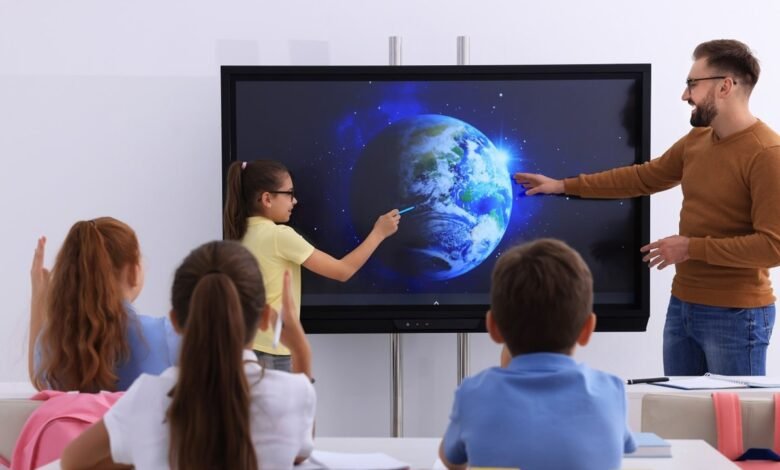Interactive Smart Boards for Classrooms: Revolutionizing Education

In today’s rapidly evolving educational landscape, technology plays a crucial role in enhancing learning experiences and improving student engagement. One of the most transformative tools in this regard is the interactive smart board. This innovative device integrates traditional teaching methods with advanced technology, creating a dynamic and interactive learning environment. In this article, we will explore the significance of interactive smart boards for classroom, their features, benefits, challenges, and future trends in educational technology.
What is an Interactive Smart Board?
An interactive smart board, often referred to as a smart board or interactive whiteboard, is a large touchscreen display that connects to a computer and a projector. It allows teachers and students to interact with digital content in real time. Users can write, draw, manipulate images, and control computer applications directly on the board’s surface. This interactive platform facilitates collaborative learning and engages students in ways traditional teaching methods cannot.
Key Features of Interactive Smart Boards
Interactive smart boards come equipped with a range of features that enhance their usability and effectiveness in the classroom:
- Touchscreen Technology: Most smart boards use capacitive or resistive touchscreen technology, allowing multiple users to interact with the board simultaneously. This feature promotes collaboration and active participation among students.
- Multi-User Capabilities: Many smart boards support multi-touch functionality, enabling several students to work together on the same screen. This fosters teamwork and collaboration, encouraging students to engage in group activities.
- Integration with Software: Interactive smart boards are compatible with various educational software and applications, making it easier for teachers to create interactive lessons. Programs such as Google Classroom, Microsoft Office, and specialized educational apps can be used to enhance the learning experience.
- Digital Annotation: Teachers can write or draw on the board using digital pens or their fingers. This feature allows for real-time note-taking, highlighting key points, and making the learning process more engaging.
- Screen Sharing: Interactive smart boards can display content from multiple devices, including laptops, tablets, and smartphones. This feature enables teachers to share student work or relevant online resources during lessons.
- Recording and Playback: Some smart boards have the capability to record lessons and presentations, allowing students to revisit the material at their own pace. This is particularly beneficial for students who may need extra time to grasp certain concepts.
- Integration with Learning Management Systems (LMS): Many smart boards can be integrated with LMS platforms, facilitating seamless access to assignments, resources, and communication between teachers and students.
Benefits of Interactive Smart Boards in Classrooms
The adoption of interactive smart boards in classrooms offers numerous benefits for both teachers and students:
- Enhanced Engagement: Interactive smart boards create an engaging learning environment where students can participate actively in lessons. The visual and tactile elements of the technology capture students’ attention, making learning more enjoyable.
- Improved Collaboration: With multi-user capabilities, students can collaborate on projects, share ideas, and learn from each other in real-time. This promotes teamwork and enhances communication skills.
- Personalized Learning: Interactive smart boards allow teachers to tailor lessons to meet the diverse needs of students. They can modify content on the fly, provide additional resources, or adjust teaching methods based on student responses.
- Access to Resources: Teachers can easily access a wealth of online resources, multimedia content, and interactive tools. This enables them to incorporate a variety of materials into their lessons, making learning more relevant and exciting.
- Facilitation of Different Learning Styles: Interactive smart boards cater to various learning styles by integrating visual, auditory, and kinesthetic learning elements. This inclusivity helps address the needs of all students, including those with learning disabilities.
- Efficient Assessment: Many smart boards come equipped with assessment tools that allow teachers to gauge student understanding in real time. Instant feedback can help teachers adjust their teaching strategies accordingly.
- Remote Learning Capabilities: In an increasingly digital world, smart boards facilitate remote learning by allowing teachers to connect with students who may be attending class from home. This flexibility ensures continuity of education.
Challenges of Implementing Interactive Smart Boards
While interactive smart boards offer significant advantages, there are also challenges associated with their implementation:
- Cost: The initial investment in smart board technology can be substantial, especially for schools with limited budgets. Beyond the hardware, ongoing maintenance and software costs can add to the financial burden.
- Training and Support: Teachers may require training to effectively use smart boards and integrate them into their teaching methods. Providing adequate professional development is essential for maximizing the technology’s potential.
- Technical Issues: Like any technology, smart boards can experience technical problems, such as software glitches or hardware malfunctions. Ensuring reliable technical support is crucial for minimizing disruptions in the classroom.
- Distraction Potential: If not used properly, interactive smart boards can become a source of distraction for students. Teachers must establish clear guidelines for their use to maintain focus on the learning objectives.
- Equity Concerns: Not all students have equal access to technology outside of school. This disparity can lead to inequities in learning opportunities and outcomes, necessitating careful consideration of how interactive smart boards are utilized.
- Over-reliance on Technology: There is a risk that teachers may rely too heavily on technology, potentially neglecting traditional teaching methods that can also be effective. Striking a balance between technology use and other instructional strategies is essential.
Future Trends in Interactive Smart Boards
As technology continues to evolve, interactive smart boards are likely to undergo significant advancements. Some emerging trends include:
- AI Integration: Artificial intelligence is poised to play a larger role in interactive smart boards, enabling personalized learning experiences. AI-driven tools can analyze student performance and adapt content to meet individual needs.
- Enhanced Connectivity: Future smart boards will likely offer improved connectivity options, allowing seamless integration with a wider range of devices and platforms. This will facilitate collaboration and content sharing among students and teachers.
- Augmented and Virtual Reality: The integration of augmented reality (AR) and virtual reality (VR) technologies with interactive smart boards can provide immersive learning experiences. Students may be able to explore virtual environments or manipulate 3D models directly on the board.
- Cloud-Based Solutions: Cloud technology will enable easier access to resources and data storage. Teachers can create and share lessons from anywhere, and students can access materials on their devices, whether in the classroom or at home.
- Data Analytics: Future smart boards may incorporate data analytics tools that provide insights into student performance and engagement. This data can inform instructional decisions and help teachers tailor their approaches to individual needs.
- Sustainability and Eco-Friendly Designs: As educational institutions become more conscious of their environmental impact, future smart boards may focus on sustainable materials and energy-efficient designs, contributing to a greener classroom.
Conclusion
Interactive smart boards represent a significant advancement in educational technology, transforming classrooms into dynamic learning environments. By fostering engagement, collaboration, and personalized learning, these tools enhance the educational experience for both teachers and students. While challenges remain in their implementation, the benefits far outweigh the drawbacks, making interactive smart boards a valuable asset in modern education.
As we look to the future, ongoing advancements in technology will continue to shape the role of interactive smart boards in classrooms. By embracing these innovations, educators can better prepare students for success in an increasingly digital world. In this ever-evolving landscape, the interactive smart board stands out as a powerful tool for fostering creativity, critical thinking, and collaboration—essential skills for the 21st century.




